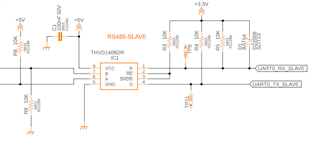Hi TI Team,
I'm selecting THVD1406 as a 485 autodirectional transceiver for a new product and I have found the following problem on the PCB prototype:
there's a low impedence path between the +5V rail and the +3.3V caused by the turn on of D1 protective diode. Attached you can see the schematic.
I think that the origin of the problem is that in default R pin goes to 5V and this turns on D1.
Anyway I need 3.3V on the UART side of the transceiver because the MCU UART pins don't accept higher voltage levels.
Should one solution be to supply THV14006 with 3.3.V? In this case, which are A-B differential voltage output levels? Should they swing between -3.3V(as negative voltage) and 6.6V (as positive voltage)?
My concern is not to lower so much the A-B differential voltage output levels using a 3.3V supply compared to 5V supply.
Or maybe another solution is to keep 5V supply is adding a series resistor between R and anode of D1 to make a voltage divider?
Thank you for the support
Alessandro

